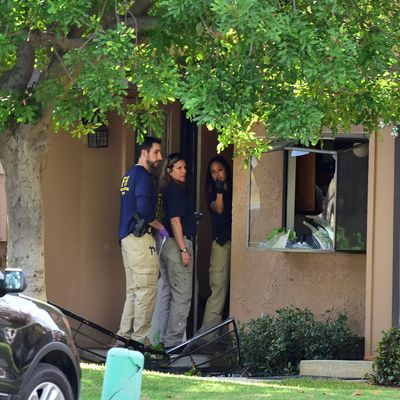
A few days after the San Bernardino shooting, federal authorities announced that they are treating the attack “as an act of terrorism.”
“There’s a number of pieces of evidence that [have] pushed us off the cliff,” David Bowdich, assistant director of the FBI’s L.A. office, said during a press conference on Friday.
Syed Rizwan Farook and Tashfeen Malik had clearly been planning an attack for some time and were in touch with at least two terror groups, according to the Los Angeles Times. On Friday, CNN reported that Malik “pledged allegiance” to ISIS on Facebook. In addition, on Saturday, an ISIS-affiliated news service said that the pair were supporters, but did not say they were members and did not indidate that ISIS was claiming responsibility for the attack, according to the AP.
At this point, officials are theorizing that it may be some combination of two motives — terrorism and workplace violence. One senior law-enforcement official told the New York Times, “You don’t take your wife to a workplace shooting, and especially not as prepared as they were. He could have been radicalized, ready to go with some type of attack, and then had a dispute at work and decided to do something.” It also remains unclear which spouse may have led the other down such a violent path.
Here’s everything we know so far.
The Latest
• The FBI announced that it is now treating the San Bernardino shooting as a terrorism case. However, there is “no indication these killers are part of a larger organized group or a cell.” Instead, it looks like the suspects were “self-radicalized and inspired by the group than actually told to do the shooting.”
• U.S. Attorney General Loretta Lynch said on Sunday that it was premature to presume that the couple was inspired by ISIS. She said the FBI has already conducted 300 interviews regarding the case.
• In his first prime-time address from the Oval office since 2010, President Obama will speak to the nation on Sunday night at 8 p.m. about the shooting, the broader threat and evolution of terrorism, and what the U.S. intends to do about it.
• In a Saturday radio broadcast, ISIS said the shooters were “supporters” but did not claim responsibility for the attack.
• More information about Tashfeen Malik, the female shooter, is emerging. A Facebook official reported on Friday that she had declared her allegiance to ISIS under a different name on the social network shortly before the attack.
• Authorities found a “bomb factory” inside the couple’s garage. According to NBC News, they “planned to use Christmas tree lights to set off their explosives.•ABC News identifies the man who purchased two of the guns used in the shooting and reports that he has checked himself into a mental institution.
Possible Terror Ties
On Friday, Attorney General Loretta Lynch and FBI Director James Comey gave brief statements on the investigation and its shift to a terrorism case. Comey stressed that there was “no indication these killers are part of a larger organized group or a cell.” However, he added that there was a lot that federal officials still didn’t understand. “There is a lot of evidence in this case that doesn’t quite make sense,” Comey said. Speaking again on Sunday, Lynch indicated that it was too early for anyone to presume that the couple had been inspired by ISIS. “I would caution people not try and define either of these two individuals right now. This investigation, if it hasn’t already been stated, is a marathon, not a sprint,” Lynch added.
Lynch did confirm, however, that Malik had declared her support for ISIS leader Abu Bakr al-Baghdadi on Facebook, using an account with a different name. NBC News reports that the post went up shortly before the shooting, and Facebook quickly took it down after the attack.
An official had previously told the New York Times, “At this point we believe they were more self-radicalized and inspired by the group than actually told to do the shooting.”
While almost everyone who knew Farook said they were shocked that he could commit such a horrific crime, one co-worker believes he became radicalized after his marriage. San Bernardino health inspector Christian Nwadike, who sat in the cubicle next to Farook’s for five years, told CBS News that when Farook “came back from Saudi Arabia, he started growing beards — that was the change,” Nwadike said. “Yes, by the wife, I think he married a terrorist.” Yet Nwadike, who was in the bathroom during the shooting, said he never saw Farook do anything violent or rude.
Several outlets reported that Farook may have been in contact with a handful of suspected extremists. According to the New York Times, he had contact with five people who had been investigated by the FBI for possible terrorist activities. One was associated with the Shabab, the Islamist militant movement in Somalia, and another was linked to Nusra Front, al-Qaeda’s Syria branch. No charges were filed against those individuals, and one official said Farook did not communicate with anyone of “significant investigative concern.”
Congressional officials said Farook’s communications with extremists were from several years ago, but officials told the L.A. Times that federal investigators are looking into three men who “were in phone contact” with Farook and Malik days before the attack. “They were associates and in contact with the shooters,” the official said.
On Friday, Bowdich said that “there are no other suspects currently under arrest [but] it is possible that there will be some in the future. We don’t know.”
Law-enforcement officials said they’re also looking into the possibility that the explosives left at the scene were based on a design in Inspire, al-Qaeda’s online magazine, but the publication is widely available online and doesn’t necessarily mean Farook and Malik were in touch with the terrorist group.
As officials told Reuters, groups like ISIS tend to attack public places to promote widespread terror, not little-known locations with personal significance for the attacker. On the other hand, the massacre doesn’t fit the mold of a lone-wolf killing either. “We don’t know if this was the intended target or if there was something that triggered him to do this immediately. We just don’t know,” Bowdich said.
George Washington University’s Program on Extremism reports that since March 2014, some 71 people in the U.S. have been charged in connection to supporting ISIS, and highlight how many shared the characteristics of being “American-born, under age 30, and [having had] no previous history of radical views or activities,” though the report also notes that “defying any cookie-cutter profile of the American ISIS supporter, these 71 individuals constitute an incredibly heterogeneous group. In fact, they come from an array of ethnic groups and a range of socio-economic and educational statuses.” They also point out that a rising number of women are being drawn to the group.
Who Was Syed Rizwan Farook?
Twenty-eight-year-old Syed Farook was born in Chicago; his parents are from Pakistan and he was raised in Southern California. He got a degree in environmental health from California State University, San Bernardino, in 2009 or 2010, and briefly attended a graduate program in environmental engineering at the California State campus at Fullerton in 2014 — campus officials told the L.A. Times they weren’t sure why he left. On Thursday, San Bernardino police chief Jarrod Burguan said Farook had “no criminal record … that we’re aware of.”
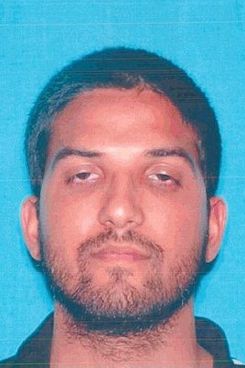
In 2006, Farook’s mother filed for divorce, claiming that his father was “mentally ill and is on medication but is also an alcoholic and drinks with the medicine,” according to the New York Times. Four years earlier, per the Post, the couple filed for bankruptcy. Farook was living with his parents at the time. “Inside the house [my husband] tried to hit me,” his mother explained. “My daughter came in between to save me … He is always mad. Screaming on me, shouting at my kids for no reason. … My son came in between to save me.” She also told the authorities that her husband “threatens to kill himself on a daily basis.”
Farook’s parents separated in 2008. Hussam Ayloush, head of the Los Angeles branch of the Council on American-Islamic Relations, said Farook’s older brother served in the U.S. military, according to Reuters.
Daily News spoke to Farook’s father, who said, “I haven’t heard anything. He was very religious. He would go to work, come back, go to pray, come back. He’s Muslim.” Farook’s brother-in-law Farhan Khan, told NBC News that Farook was a “normal person … as normal as you can think.” He added that “something … stupid that something like this doesn’t relate to my religion. I am Muslim. I’m a good person. And there’s a lot of good Muslims there. He was a bad person, that was his personal act.”
Farook had profiles on several dating websites, including one that said it was “for people with disabilities and second marriage.” One profile said, according to The Guardian, “Enjoy working on vintage and modern cars, read religios [sic] books, enjoy eating out sometimes travel and just hang out in back yard doing target pratice [sic] with younger sister and friends.” He also described himself as “religious but modern.” He said on the dating site ArabLounge.com, according to Reuters, “I try to live as a good Muslim.”
Who Was Tashfeen Malik?
Farook met his 29-year-old wife Malik, who was born in Pakistan, on the internet, and traveled to Saudi Arabia in 2013 to meet her in person. Hussam Ayloush, director of the Los Angeles Council on American-Islamic Relations, said family members introduced them, which is common in the Pakistani Muslim community. Nazeem Ali, who attended Farook’s mosque, said he told him he planned to meet his fiancée in Saudi Arabia and get married at the Black Stone in the Grand Mosque of Mecca.
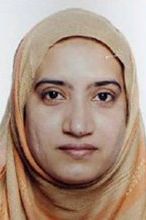
According to the Times, Farook’s brother-in-law says the suspect traveled to Saudi Arabia at least twice to see Malik. (There are also conflicting reports about whether he traveled to Pakistan.) She came to the U.S. in July 2014, according to FBI official David Bowdich, on a K-1 fiancée visa, which gives couples 90 days to get married. Malik applied for permanent resident status on September 30, 2014, and she was issued a conditional green card in July 2015. The process involved criminal and national-security background checks using FBI and Department of Homeland Security databases. According to ABC News, a Saudi government official has said that she was not on any of their watch lists.
Mustafa Kuko, director of the Islamic Center of Riverside, said the couple had their wedding reception at the mosque two years ago. “By nature he’s a quiet person,” Kuko said, “but on that night he was very happy.”
It seems few people in the U.S. knew Malik well. Unlike her husband, she did not attend the mosque regularly. Reuters reported on Friday that Malik first moved to Saudi Arabia 25 years ago, and she returned to Pakistan about five years ago, where she was apparently planning to study pharmacy. (Saudi authorities, however, say they have no record of her residency in Saudi Arabia.) The Los Angeles Times reports that Malik belonged to an educated, politically-influencial family in Pakistan, and that some members of that family are known to have connections to militant Islam. Pakistani intelligence agents have now questioned members of Mailk’s extended family as well.
According to the AP, a relative in Pakistan said that Malik apparently became a more zealous follower of Islam roughly three years ago, and began wearing a burka at that time. A San Bernardino acquaintance of Farook’s says that she wore a niqab and that Farook admired her for that, as well as for her religious conservatism.
The Farook family attorney, David Chesley, has been making the rounds on TV, telling reporters that the official narrative of the attack doesn’t make sense to him. He told CNN, “It just doesn’t make sense for these two to be able to act like some kind of Bonnie and Clyde or something. It’s just ridiculous. It doesn’t add up.” He added that he was especially confused about the reports concerning Malik, as “she’s probably about 90 pounds, so it’s unlikely she could even carry a weapon or wear some type of a vest or do any of this.” The Farook family’s lawyers also said that Malik was “just a housewife” who wore traditional Muslim clothing. The attorneys said that as a result of her covering her face, even her brothers-in-law had never seen what she looked like.
Chesley also gave reporters, according to the Daily Mail, the less-than-compelling argument that “There was a lot of questions drawn with regards to Sandy Hook and whether or not that was a real incident or not. We just don’t know.”
It’s extremely rare for a woman to be involved in a mass shooting. According to Reuters, an NYPD report found that out of 230 U.S.“active shooter” incidents between 1966 and 2012, only eight involved female attackers; an FBI study of 160 active shooter incidents from 2000 and 2013 found only six involved women.
The couple had a 6-month-old girl, whom they dropped off at Farook’s mother’s house before the attack, saying Malik had to go to a doctor’s appointment. The baby is now in the custody of Child Protective Services. Brother-in-law Farhan Khan told NBC News that he has begun the process to adopt the baby.
Farook’s Job
Farook had worked at the San Bernardino Department of Public Health for five years as an environmental-health specialist. The job required him to inspect “public pools and eating establishments … check the cleanliness of food surfaces and cooling methods, analyze chlorine levels, and test kitchen equipment,” according to the Washington Post.
Co-workers said he was “quiet and polite,” the L.A. Times reports, but others said he could he could be chatty about particular subjects, such as cars. One former co-worker said the office threw a baby shower for him before he went on paternity leave. Patrick Baccari, who shared a cubicle with Farook and was injured in the attack, said he thought he had been “living the American dream.”
Nicholas Thalasinos, who was killed in the attack, had a dispute with Farook about two weeks before the attack, according to the victim’s friend Kuuleme Stephens. She said she called Thalasinos, a Messianic Jew who was passionately pro-Israel, at work while he was having a discussion with another restaurant inspector. Thalasinos mentioned Farook by name, and said he “doesn’t agree that Islam is not a peaceful religion.” She said Farook replied that Americans don’t understand Islam. The men regularly discussed politics and religion and Stephens said she had no reason to think their discussions would turn violent.
The Day of the Attack
Farook attended the annual holiday party last year, and nothing out of the ordinary happened. This year, however, Farook left the party at the Inland Regional Center seemingly upset, shortly before the group gathered for a photo. Police said they received information from someone who was concerned about his behavior at the event.
He left his jacket and papers behind. Someone noticed he was missing and said, “Where’s Syed?” according to the Washington Post. Farook returned about 15 to 30 minutes later with Malik. They silently sprayed the room with bullets, pausing to reload. They also left three pipe bombs in the conference center, but the remote-control trigger didn’t work.
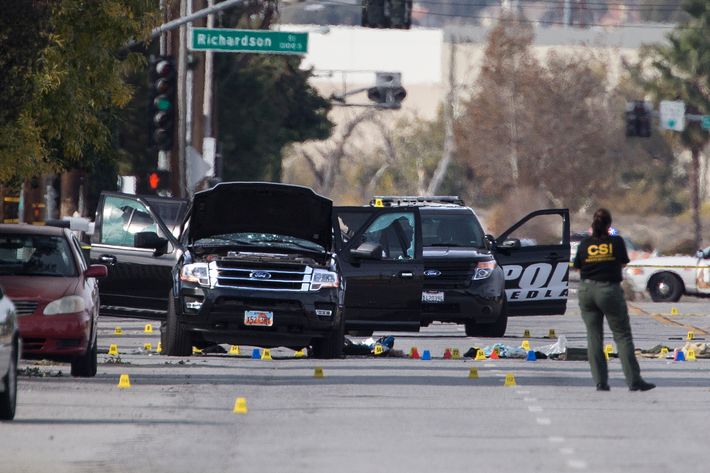
Four hours later, police closed in on their Redlands home, and they fled in a black SUV. After a car chase that led back to San Bernardino, Farook and Malik were killed in a shoot-out with about 20 officers.
During a press conference on Thursday, San Bernardino police chief Jarrod Burguan told reporters that it definitely appeared as if the attack was preplanned. “Nobody gets upset at a party and puts together that kind of elaborate scheme or planning to do that,” he said.
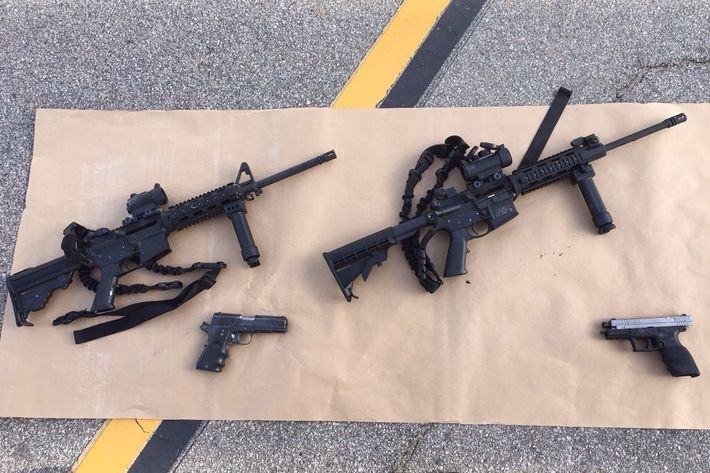
Their Arsenal
The suspects rented a house in Redlands, a city ten miles away from downtown San Bernardino. Burguan says “they came prepared to do what they did, as if they were on a mission,” something officials quickly realized when they looked inside the couple’s home. There were 12 pipe bombs and thousands of rounds of ammunition inside. “There were also hundreds of tools, many of which could be used to construct IEDs or pipe bombs,” Burguan said on Thursday. “Clearly they were equipped and they could have done another attack,” Burguan added.
NBC News reported on Friday that there was a “bomb factory” in the couple’s garage. They reportedly “planned to use Christmas tree lights to set off their explosives.”
The ATF says that all four guns used in the shooting were purchased legally. Two “were purchased by someone who is already known by investigators,” according to CBS News. Farook bought the two handguns, but not the two rifles. The Los Angeles Times reports that the guns were purchased at the “family-friendly” Annie’s Get Your Gun in Corona, California.
On Sunday, a San Francisco ABC News affiliate reported that the two “assault-style” rifles used in the attack were purchased about three years ago by a man named Enrique Marquez, who was identified as “Syed Farook’s former neighbor.” The authorities raided Marquez’s home in Riverside over the weekend, though FBI Director James Comey said he is “not a suspect, at least at this point.” Marquez reportedly checked himself into a mental institution right after the shooting.
A source told NBC News that it appears the couple tried to modify one of the rifles to be fully automatic, but they were unsuccessful. Authorities are currently trying to figure out why the suspects seemed so familiar with “military-style tactics,” according to the Times.
After searching the couple’s home, federal investigators seized “an iPhone, a bank receipt, audio cassettes … a notebook with foreign language writing … a U-Haul receipt, [and] packaging for a Go Pro camera,” along with weapons and electronics, according to the Los Angeles Times.
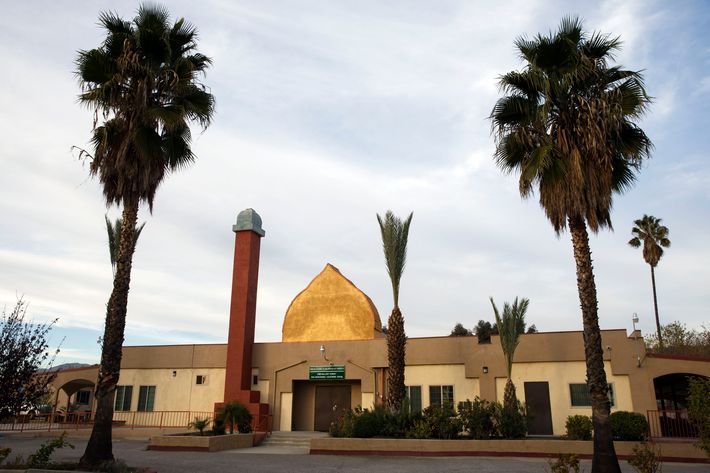
Preparations for the Attack
In addition to amassing a stock of weapons, three or four days before the massacre the couple rented the black Ford Expedition they used as a getaway car. At least a day before the attack, they began destroying data on their electronic devices. “It’s not like he got angry and came back and started deleting and destroying things,” one law-enforcement official told the New York Times. There were two “crushed” phones found in a trash can not far from where the shooting happened. The phone Malik was carrying during the shoot-out was almost empty, suggesting it may have been a “burner” phone.
While Farook was known to pray every day at his mosque, sometimes even twice per day, his friends Nizaam and Rahemaan Ali said he abruptly stopped attending three weeks ago. The brothers told the AP he seemed happy and normal the last time they saw him. “He never, ever talked about killing people or discussed politics, or said that he had problems at work,” Rahemaan Ali said. “I can’t believe it. There’s no way to express the shock I’m in,” Nizaam Ali added. “This was a person who was successful, who had a good job, a good income, a wife and a family. What was he missing in his life?”
This post has been updated throughout.





























